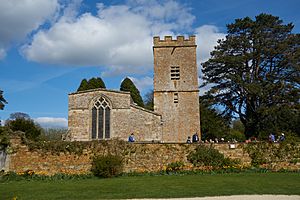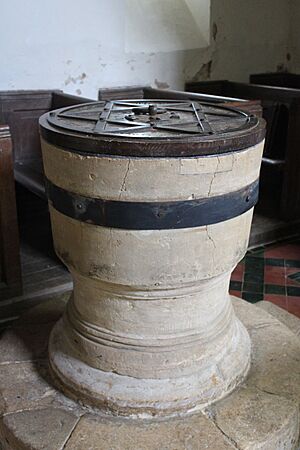St Mary's Church, Chastleton facts for kids
Quick facts for kids St Mary the Virgin, Chastleton |
|
|---|---|

St Mary's seen from the west from the grounds of Chastleton House
|
|
| Lua error in Module:Location_map at line 420: attempt to index field 'wikibase' (a nil value). | |
| OS grid reference | SP24862906 |
| Location | Chastleton, Oxfordhire |
| Country | England |
| Denomination | Church of England |
| Previous denomination | Roman Catholic |
| Website | Around the Benefice |
| History | |
| Dedication | St Mary the Virgin |
| Architecture | |
| Functional status | Active |
| Heritage designation | Grade II* listed |
| Designated | 27 August 1957 |
| Specifications | |
| Materials | Cotswold stone |
| Administration | |
| Deanery | Chipping Norton |
| Archdeaconry | Oxford |
| Diocese | Oxford |
| Province | Canterbury |
The Church of St Mary the Virgin is a special church in Chastleton, Oxfordshire, England. It is part of the Church of England. This church serves the local community and is connected to other nearby churches in places like Little Compton, Cornwell, and Daylesford. All these churches work together as a "Benefice" (a group of parishes) based in Chipping Norton. This larger group is part of the Diocese of Oxford, which is a big area managed by the Church of England.
The church was first built around the year 1100. It was made bigger in 1320. The tall bell-tower you see today was added much later, in 1689. The church was carefully repaired and updated between 1878 and 1880. Because of its history and special design, it is listed as a Grade II* building, meaning it's very important.
Contents
History of the Church Building

St Mary's church was built a very long time ago, around the year 1100. From this first church, which was built in a style called Norman architecture, only a few parts remain. These include a door in the north wall, some arched pillars, and possibly the baptismal font (a large basin used for baptisms).
Around 1320, the chancel (the area around the altar) was built. Part of the north wall was made wider, and a south aisle was added. This aisle was used to create special small chapels called chantry chapels.
South Aisle Chapel Details
This chapel officially became a chantry in 1336. A chantry was a place where priests would pray for the souls of specific people, often wealthy families. Robert Trillowe, who lived where Chastleton House is now, likely helped pay for it. The floor still has old, glazed tiles from the 1300s.
The east window in the chapel shows pictures of the four Evangelists (Matthew, Mark, Luke, and John from the Bible). The south window shows scenes from when Jesus was a child.
The wooden panels on the east wall are from the 1600s, as are some of the pews (church benches). The ceiling was added in the Victorian era (late 1800s). It has the coats of arms (family symbols) of five families who owned Chastleton Manor over time: Trillowe, Catesby, Jones, Whitmore, and Whitmore-Jones. Some members of these families are buried in a vault underneath the chapel.
The altar (the table where communion is served) in this chapel was designed in 1993 by Mr. Poole from a nearby village. Its design matches the old 14th-century pillars next to it.
Chancel Area
The carved wooden decorations behind the main altar might be what's left of a rood screen. A rood screen was a tall, decorated screen that used to stand between the chancel and the main part of the church. Underneath the chancel, some members of the Jones family and former church rectors (head priests) were buried.
On the floor of the south aisle, near the lectern (a stand for reading lessons), there are two special metal plates called brasses. One remembers Katherine Throckmorton, who passed away in 1592. She was the grandmother of Robert Catesby. The other brass remembers Edmund Ansley, who passed away in 1613.
The vestry (a room where clergy prepare) was added to the church in 1853.
Pulpit and Seating
The pulpit (where the priest gives sermons) is from the Jacobean period (early 1600s). It might have been made by the same person who created much of the wood paneling in Chastleton House. It has the date 1623 carved on it. Originally, it was a "triple-decker" pulpit, meaning it had three levels, including a desk for reading and a desk for the clerk. It used to be on the other side of the chancel arch.
The pews (benches) in the main part of the church (nave) and the chancel are Victorian. They replaced older oak benches from the Jacobean period. Three of these older, high-backed pews can still be seen in the South aisle chapel.
North Aisle and Organ
The church organ now covers a stone piscina. A piscina is a small basin with a drain, used for washing sacred vessels. This piscina is the only sign that there might have been another chantry chapel in this area long ago. The current organ was built and put in place by J. W. Walker & Sons Ltd in 1937. Before that, Walter Newman was the organist for 49 years. In the Middle Ages, the church had a gallery at the west end where a "West Gallery band" would play music.
Wall Paintings
On the north wall of the church, there are important examples of wall paintings from the 1600s and 1700s. These paintings might have once covered the entire wall. Most of them were found in the 1930s and show religious teachings like The Ten Commandments and The Lord's Prayer. Another painting on the south wall, showing The Last Judgement, was found in 1878 but was covered up again soon after.
West End of the Church
The large window at the west end of the church is from the 14th century, but the glass in it was added in the 1900s. There used to be a gallery (a raised platform) at the west end, which was reached by a stairway. The small window for this stairway can still be seen, but the gallery itself was removed in 1878. The baptismal font in this area is believed to be from the 13th century or even earlier.
Church Bells
The church tower has a set of six bells that are used for Change ringing (a special way of ringing church bells). The third bell was made in 1696 by Richard Keene. Until 1726, there were only three bells. Then, the number increased to four. Henry III Bagley made the fourth and fifth bells in 1731. The second bell was made by Matthew III Bagley in 1762. Finally, John Rudhall of Gloucester made the first (treble) bell in 1811 and the largest (tenor) bell in 1825, bringing the total to six.
The bells were repaired and updated in 1900 by Henry Bond. In 1993, almost £40,000 was raised to have the bells re-tuned and re-hung. The Whitechapel Bell Foundry re-tuned them, and Whites of Appleton re-hung them in a new steel frame.
A team from the village regularly rings the bells, helped by ringers from the nearby church in Salford. The room where the bells are rung is on the first floor of the tower. You enter the tower through the south door and then climb a short ladder-like set of steps to reach the ringing chamber. There's a trap-door at the top that is closed when the bells are being rung.
Churchyard Burials
On the north side of the churchyard, next to Chastleton House, is the tomb of Sir Richard Westmacott (1775–1855). He was a very famous sculptor during the Victorian era.
Other important people buried in the churchyard include Alan Clutton-Brock from Chastleton House, Newbury Racecourse manager Geoffrey Freer, and CLT Walwyn, who was the father of famous racehorse trainer Peter Walwyn.
Families Connected to the Church
Many families have played a big part in the history of St Mary's Church and Chastleton village.
Trillowe Family
The Trillowe family lived where Chastleton House is now from about 1302. Records show three family members: John (1302), Robert (who supported the Chantry in 1336), and another John (1360). John's great-granddaughter, Phillippa Bishopsden, married William Catesby in the 1400s.
Catesby Family
William Catesby, the son of Phillippa and William, worked for King Richard III. The family line continued through George, Richard, and two more Williams. The last William married Anne Throckmorton. Their son was Robert Catesby, who was involved in the Gunpowder Plot. He lived at Chastleton in 1601, and his son, Robert Catesby Junior, was baptized at the church on November 11, 1595. In 1602, after a large fine for his part in the Essex Rebellion, Catesby had to sell Chastleton House to Walter Jones.
Throckmorton Family
In 1555, Anthony Throckmorton married Katherine, who was the widow of William Catesby. They had nine children.
Ansley Family
Edmund Ansley married Margaret Throckmorton. The Ansley family lived at Brookend, taking it over from Eynsham Abbey after the Dissolution of the monasteries (when monasteries were closed down). Edmund passed away in 1613 and is buried in the chancel.
Greenwood Family
Around 1588, the Greenwood family became the patrons of Chastleton church, meaning they had a say in who became the rector. They kept this role until 1784. The Greenwood family's house was across from the church, but it was destroyed in the 1800s. In 1608, George Greenwood married Elizabeth, the oldest daughter of Walter Jones.
Jones Family
Walter Jones (born around 1550, passed away 1632) was the son of a wool merchant. He bought Chastleton House in 1602. He might have moved in around 1605. Walter Jones married Elinor Pope, who was a special attendant to Queen Elizabeth I. Walter Jones started building the current Chastleton House in 1603 and mostly finished it by 1614. He passed away in 1632 and was buried in the chancel, though his tombstone is no longer visible.
The ownership of Chastleton House passed down through the Jones family for many generations.
Inside the church, there are wall-mounted monuments (memorials) to members of the Jones family. Two notable ones are for Sarah Jones (passed away 1687), which has decorations and small angel figures, and for Anne Jones, who passed away in 1708.
Whitmore Jones Family
John Henry had to change his name to Whitmore Jones to inherit Chastleton House. He had four sons, none of whom married. When the last son passed away in 1874, the house went to the oldest of John Henry's six daughters, Mary. She was the first female heir to the house. In 1900, she gave the house to her nephew, Thomas Harris, who also changed his name to Whitmore Jones. He married his cousin, Irene Dickins. Mary passed away in 1915, and Thomas in 1917.
Irene moved into Chastleton House in 1933, after the Richardson family, who had been renting it for 37 years, moved out.
Clutton-Brock Family
In 1937, Alan Clutton-Brock joined Irene Whitmore Jones at Chastleton House. Soon after, he married Barbara Foy-Mitchell, and they moved away. But when Irene passed away in 1955, the Foy Clutton-Brocks moved back to the house. Alan passed away in 1976, but Barbara stayed until 1992, when the house was sold to the National Trust.
Richardson Family
Mr. and Mrs. CT Richardson rented Chastleton House between 1896 and 1933. They did a lot of important work to restore and improve the gardens around the house.

